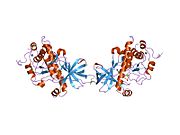TRPM7
Transient receptor potential cation channel, subfamily M, member 7, also known as TRPM7, is a human gene encoding a protein of the same name.
Function[edit]
TRPs, mammalian homologs of the Drosophila transient receptor potential (trp) protein, are ion channels that are thought to mediate capacitative calcium entry into the cell. TRP-PLIK is a protein that is both an ion channel and a kinase. As a channel, it conducts calcium and monovalent cations to depolarize cells and increase intracellular calcium. As a kinase, it is capable of phosphorylating itself and other substrates. The kinase activity is necessary for channel function, as shown by its dependence on intracellular ATP and by the kinase mutants.[5]
Interactions[edit]
TRPM7 has been shown to interact with PLCB1[6] and PLCB2.[6]
Clinical relevance[edit]
Defects in this gene have been associated with magnesium deficiency in human microvascular endothelial cells.[7]
See also[edit]
References[edit]
- ^ a b c GRCh38: Ensembl release 89: ENSG00000092439 – Ensembl, May 2017
- ^ a b c GRCm38: Ensembl release 89: ENSMUSG00000027365 – Ensembl, May 2017
- ^ "Human PubMed Reference:". National Center for Biotechnology Information, U.S. National Library of Medicine.
- ^ "Mouse PubMed Reference:". National Center for Biotechnology Information, U.S. National Library of Medicine.
- ^ "Entrez Gene: TRPM7 transient receptor potential cation channel, subfamily M, member 7".
- ^ a b Runnels LW, Yue L, Clapham DE (May 2002). "The TRPM7 channel is inactivated by PIP(2) hydrolysis". Nat. Cell Biol. 4 (5): 329–36. doi:10.1038/ncb781. PMID 11941371. S2CID 21592843.
- ^ Baldoli E, Maier JA (2012). "Silencing TRPM7 mimics the effects of magnesium deficiency in human microvascular endothelial cells". Angiogenesis. 15 (1): 47–57. doi:10.1007/s10456-011-9242-0. PMID 22183257. S2CID 16274084.
Further reading[edit]
- Chubanov V, Gudermann T, Schlingmann KP (2005). "Essential role for TRPM6 in epithelial magnesium transport and body magnesium homeostasis". Pflügers Arch. 451 (1): 228–34. doi:10.1007/s00424-005-1470-y. PMID 16075242. S2CID 6037803.
- Clapham DE, Julius D, Montell C, Schultz G (2005). "International Union of Pharmacology. XLIX. Nomenclature and structure-function relationships of transient receptor potential channels". Pharmacol. Rev. 57 (4): 427–50. doi:10.1124/pr.57.4.6. PMID 16382100. S2CID 17936350.
- Penner R, Fleig A (2007). "The Mg2+ and Mg(2+)-nucleotide-regulated channel-kinase TRPM7". Transient Receptor Potential (TRP) Channels. Handbook of Experimental Pharmacology. Vol. 179. pp. 313–28. doi:10.1007/978-3-540-34891-7_19. ISBN 978-3-540-34889-4. PMC 5663631. PMID 17217066.
External links[edit]
- TRPM7+protein,+human at the U.S. National Library of Medicine Medical Subject Headings (MeSH)
This article incorporates text from the United States National Library of Medicine, which is in the public domain.








